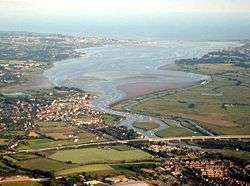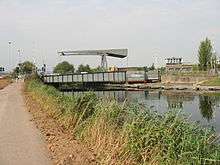Exeter Ship Canal
The Exeter Ship Canal, also known as the Exeter Canal is a canal leading from (and beside) the River Exe to Exeter Quay in the city of Exeter, Devon, England. It was first constructed in the 1560s[1][2] predating the "canal mania" period and is one of the oldest artificial waterways in the UK.
| Exeter Canal | |
|---|---|
| Location | Beside the River Exe |
| Country | England |
| Geography | |
| Start point | River Exe |
| End point | Exeter Quay |
Exeter Ship Canal | |||||||||||||||||||||||||||||||||||||||||||||||||||||||||||||||||||||||||||||||||||||||||||||||||||||||||||||||||||||||||||||||||||||||||||||||||||
|---|---|---|---|---|---|---|---|---|---|---|---|---|---|---|---|---|---|---|---|---|---|---|---|---|---|---|---|---|---|---|---|---|---|---|---|---|---|---|---|---|---|---|---|---|---|---|---|---|---|---|---|---|---|---|---|---|---|---|---|---|---|---|---|---|---|---|---|---|---|---|---|---|---|---|---|---|---|---|---|---|---|---|---|---|---|---|---|---|---|---|---|---|---|---|---|---|---|---|---|---|---|---|---|---|---|---|---|---|---|---|---|---|---|---|---|---|---|---|---|---|---|---|---|---|---|---|---|---|---|---|---|---|---|---|---|---|---|---|---|---|---|---|---|---|---|---|---|
| |||||||||||||||||||||||||||||||||||||||||||||||||||||||||||||||||||||||||||||||||||||||||||||||||||||||||||||||||||||||||||||||||||||||||||||||||||
History
At the start of Exeter's history, the River Exe was tidal and navigable up to the city walls enabling it to be a busy port. In the 1270s or 1280s, the Countess of Devon, Isabella de Fortibus, built a weir across the river to power her mills (this weir is remembered in the name of the nearby suburb Countess Wear).[3] This had the effect of cutting off Exeter's port from the sea and damaging its salmon fisheries. In 1290, trade with Exeter's port was restored, only to be blocked by a new weir built in 1317 by Hugh de Courtenay, 9th Earl of Devon (Isabella's cousin), who also built a quay at Topsham.[3] Because of the blockages on the river, boats were forced to unload at Topsham and the earls were able to exact large tolls to transport goods to Exeter.[4] For the next 250 years the city petitioned the King to have the waterway reopened, to no avail, until 1550 when Edward VI finally granted permission. However, it was by then too late because the river channel had silted up.[3]
In 1563, Exeter traders employed John Trew of Glamorgan to build a canal to bypass the weirs and rejoin the River Exe in the centre of the city where a quay would be built. Work began in February 1564, and was completed in Autumn 1566[5] or early 1567.[6] The canal had three locks with vertical gates – the first pound locks to be built in Britain. They accommodated boats up to 16 tonnes.[7] The original cut was 3 feet (0.91 m) deep and 16 feet (4.9 m) wide (0.9 m by 5 m). It ran one and three and a quarter miles (5.2 km) from just below the Countess Weir to the centre of Exeter. This navigation was not very effective; it could not be entered at all states of the tide, and the double transfer of cargo over such a short distance made it uncompetitive with road transport.[8] The weir that maintains the water level in the quay is still named "Trew's Weir" after the canal's builder.

In 1677 the canal was extended and the entrance was moved downstream to Topsham. In 1701 the canal was deepened and widened to allow the passage of ocean-going ships. At the same time the number of locks on the canal was reduced to one. Floodgates were also fitted to the canal entrance. These improvements led to the canal being highly successful until demand for access declined with the end of the wool trade in the early nineteenth century and later with the rise of the railways.
There were many notable failures to connect Exeter and the South West to the national canal and rail networks: The Grand Western Canal linking Exeter to Bristol (1796) was never completed; The Bristol & Exeter Railway link to the canal basin was postponed in 1832 and 1844; The South Devon Railway ran services to the canal from 1867, but by this time the canal was too small to attract the sizeable ocean-going vessels and the canal was taken over by its creditors for sixteen years. Use of the canal has declined gradually ever since.

20th century
In 1939 the canal was still carrying some 63,000 tons of material annually, and after the war it was still seen as a useful means of transporting goods to and from its basin at Haven Banks, opposite Exeter Quay. Planning for the city after The Blitz recommended that Turf Lock, the canal's junction with the estuary be deepened and enlarged to allow ships of 600 tons to pass.[9]
In May 1944 the bridge was used in rehearsals for the D-Day attack on the 'Canal de Caen' (Pegasus Bridge) and the River Orne (Horsa Bridge), by the Second Battalion Oxfordshire and Buckinghamshire Light Infantry. A plaque acknowledging this is sited on the south side of the bridges on the east bank.
The last commercial use of the canal was in 1972 when the Esso Jersey (now known as the "Kieler") left the canal basin, carrying oil to its terminal in New Jersey. However, the water board continued to run a sludge tanker, the Countess Weir, until 1997; originally a government-owned body, the water board was privatised in 1989.
The fall of commercial traffic in the 1960s coincided with the rise of leisure use of the canal. After some recent issues with the dumping of used marine-related equipment, the future of the canal looks bright with the city basin being included in part of a £24 million redevelopment. The quay area has been subject to redevelopment over recent years and is continuing to be converted to wider recreational use. The canal basin itself is popular for a range of water sports.
Throughout the year the Butts Ferry, a small hand powered passenger ferry, operates across the river by Exeter quay and canal basin during the day, though there is a footbridge close at hand. A ferry has been operating here since at least 1641.[10]
See also
- Canals of Great Britain
- History of the British canal system
References
- David Cornforth (February 2012). "Exeter Canal and Quayside - a short history". www.exetermemories.co.uk. Retrieved 14 September 2013.
- "Exeter Ship Canal, The First Four Hundred Years". www.exeter.gov.uk. Archived from the original on 19 September 2015. Retrieved 13 September 2013.
- "Exeter Memories - Countess Wear". www.exetermemories.co.uk. Archived from the original on 7 February 2008. Retrieved 12 March 2008.
- "Exeter Memories - Topsham, a short history". www.exetermemories.co.uk. Archived from the original on 15 March 2008. Retrieved 12 March 2008.
- Clew, Kenneth R. (1984). The Exeter Canal. Chichester: Phillimore. ISBN 0-85033-544-2.
- "The city of Exeter, Letters and other papers". British History Online. Retrieved 23 October 2008.
- Blair, John (2007), Waterways and Canal-Building in Medieval England, Oxford University Press, ISBN 978-0-19-921715-1
- Jackman, W. T. (1916), The Development of Transportation in Modern England, Cambridge University Press
- Sharp, Thomas (1946). Exeter Phoenix - A Plan for Rebuilding. Exeter City Council. p. 81.
- Exeter Memories, Butts Ferry Archived 26 June 2009 at the Wayback Machine, accessed 2010-11-10
External links
